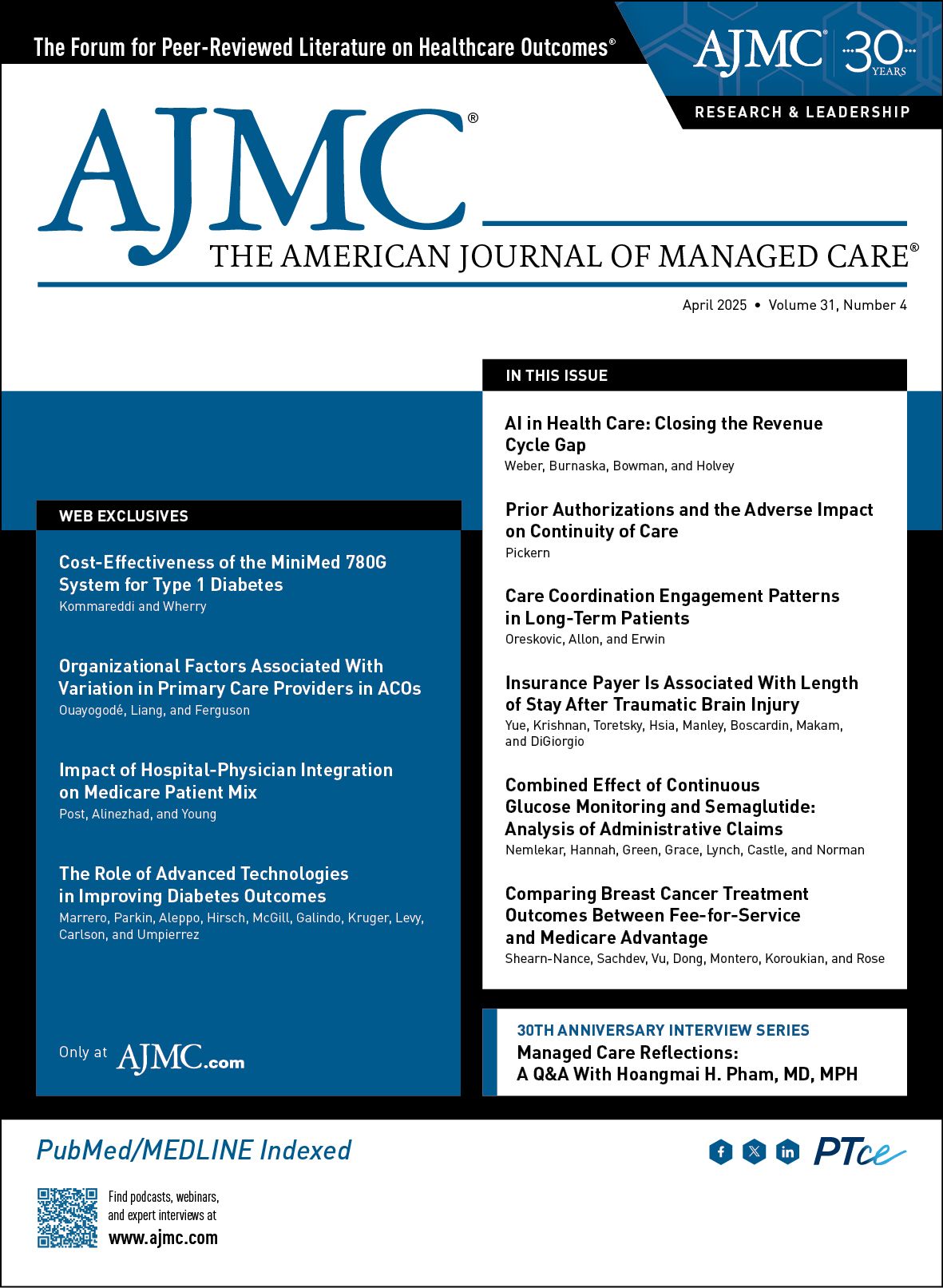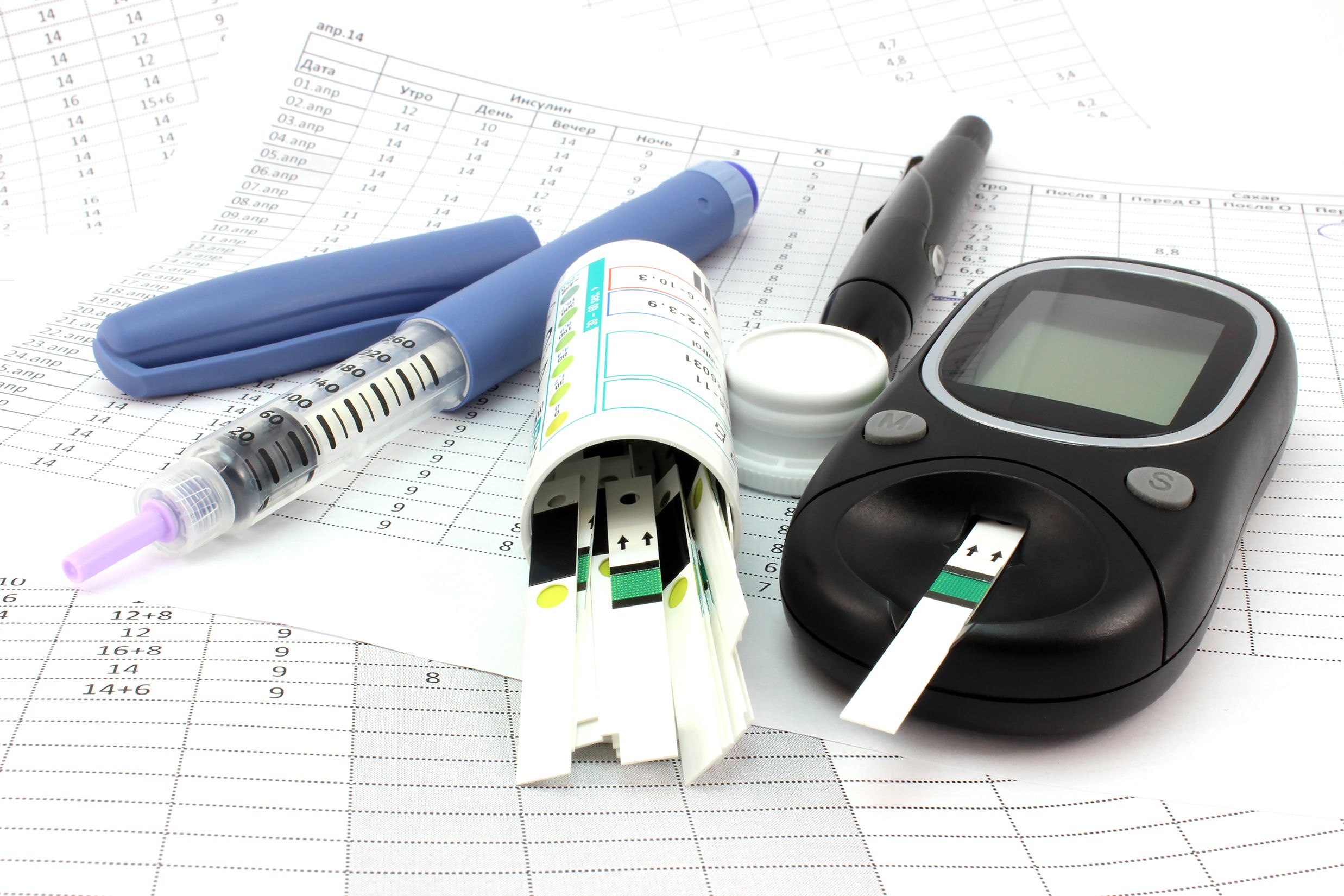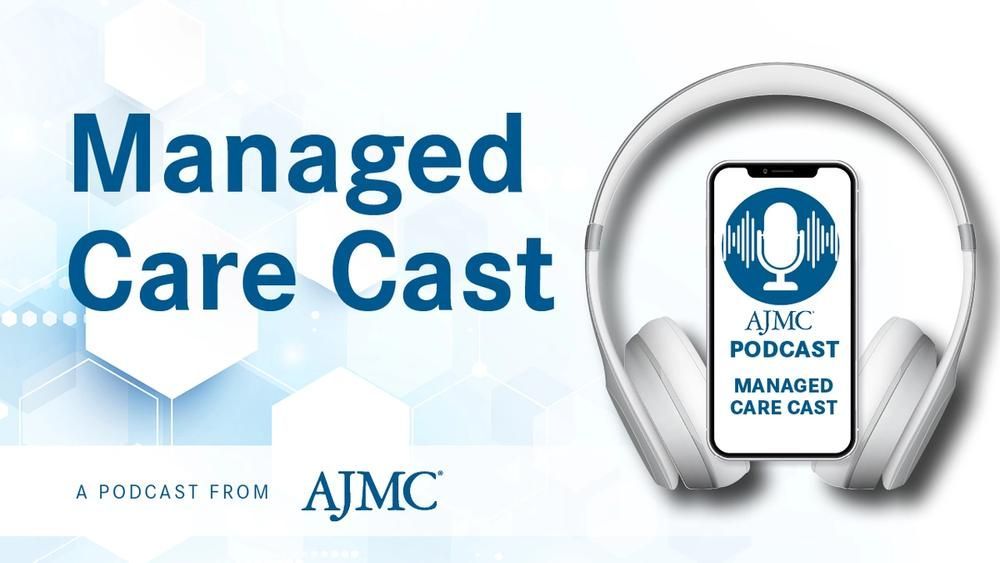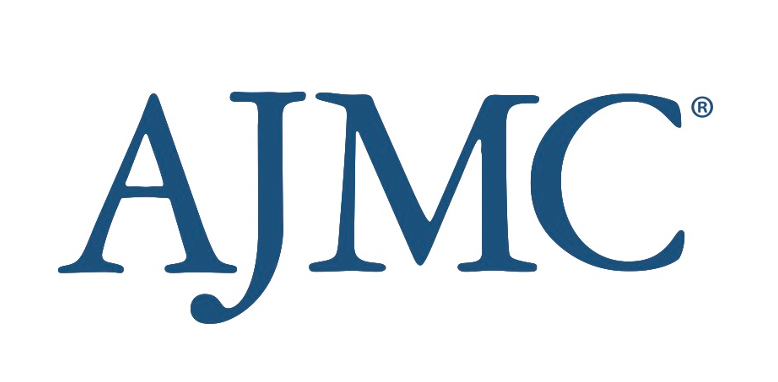Publication
Article
The American Journal of Managed Care
Combined Effect of Continuous Glucose Monitoring and Semaglutide: Analysis of Administrative Claims
Author(s):
Claims data reveal larger hemoglobin A1c decreases in people with type 2 diabetes who use continuous glucose monitoring and semaglutide compared with semaglutide alone.
ABSTRACT
Objectives: This study evaluated whether the combined use of continuous glucose monitoring (CGM) and semaglutide, a glucagon-like peptide-1 receptor agonist, was associated with larger hemoglobin A1c (HbA1c) improvements compared with use of semaglutide alone.
Study Design: Using US health care claims data from the Optum Clinformatics database, this retrospective analysis identified adults with type 2 diabetes (T2D) using semaglutide.
Methods: The CGM cohort had at least 1 CGM-related claim between January 1, 2019, and September 30, 2022. Random index dates were used in the control (non-CGM) cohort. At least 1 laboratory HbA1c value was required during baseline and follow-up periods. Outcomes included change in HbA1c and the proportion of people who reached American Diabetes Association (ADA) or Healthcare Effectiveness Data and Information Set (HEDIS) HbA1c targets of less than 7.0% or less than 8.0%, respectively.
Results: A total of 21,247 people with T2D were identified, with 18,488 in the control group and 2759 using CGM. Overall, a significantly greater reduction in HbA1c was observed in the CGM cohort compared with the control group (difference-in-differences, –0.55%; 95% CI, –0.64% to –0.47%; P < .0001). Among CGM users, the proportion meeting the ADA target of HbA1c less than 7.0% nearly doubled, and the proportion achieving the HEDIS target of HbA1c less than 8.0% increased by more than 50%.
Conclusions: The results suggest that CGM provides an additive benefit to semaglutide, leading to greater decreases in HbA1c. Expanded use of these complementary therapies in the primary care setting could enable more people with T2D to achieve their glycemic goals.
Am J Manag Care. 2025;31(4):183-188. https://doi.org/10.37765/ajmc.2025.89719
Takeaway Points
Many people with type 2 diabetes are not meeting glycemic targets, such as a hemoglobin A1c (HbA1c) level of less than 7.0%. This analysis of administrative claims data found that combined use of continuous glucose monitoring (CGM) and semaglutide was associated with larger decreases in HbA1c compared with semaglutide use alone.
- Users of CGM and semaglutide lowered their HbA1c by 0.55% more than users of semaglutide alone.
- The proportion of CGM and semaglutide users achieving HbA1c less than 7.0% doubled between baseline and follow-up.
- These results suggest an additive effect of CGM and semaglutide, and their combined use could help more people with type 2 diabetes reach their glycemic targets.
Type 2 diabetes (T2D) is a significant and growing health concern.1,2 Almost half of individuals with T2D in the US are not reaching glycemic goals, such as a hemoglobin A1c (HbA1c) level of less than 7.0%.1,3 Primary care providers (PCPs) are critical to the success of diabetes management because they overwhelmingly provide clinical care to this population,4,5 and they are encouraged to consider individual preferences and treatment efficacy when recommending or adjusting therapies.6
Glucagon-like peptide-1 receptor agonists (GLP-1 RAs) have emerged as highly effective treatments for T2D. The American Diabetes Association (ADA) recommends the use of GLP-1 RAs as a second-line therapy after metformin for glycemic management.6 For certain populations, such as those with T2D and cardiovascular disease, the ADA recommends GLP-1 RAs as a first-line therapy. Semaglutide, a highly effective GLP-1 RA, reduces HbA1c when used as a monotherapy7,8 or in combination with other antidiabetic medications in people with T2D.9,10 Semaglutide is available in 2 formulations: injectable versions (Ozempic and Wegovy; Novo Nordisk) that were approved by the FDA in December 2017 and May 2021, respectively, and an oral formulation (Rybelsus; Novo Nordisk) that was approved in September 2019. Both formulations lower HbA1c and provide cardiovascular benefits,11-13 but users of the injectable formulation typically experience greater improvements in glycemia, including achievement of glycemic goals such as HbA1c less than 7.0%.14
Diabetes management requires knowledge of one’s glucose levels. Historically, people with diabetes were instructed to self-monitor their blood glucose (SMBG) by measuring their capillary blood glucose values through finger stick testing. However, SMBG is a painful, cumbersome, and often-neglected task.15 By contrast, continuous glucose monitoring (CGM) provides estimated glucose values every 1 to 5 minutes directly to a user’s smartphone, allowing for retrospective data analysis and real-time alerts that inform users of abnormal glucose concentrations or trends.
Although studies have shown that the use of CGM or semaglutide among people with T2D can improve HbA1c and glycemic control, we hypothesized that use of both therapies would yield additional glycemic benefits. In this real-world retrospective analysis of a US health care claims database, we assessed the association between CGM use and glycemic control among semaglutide users with T2D.
METHODS
Data Source
This was a retrospective, observational database study using deidentified administrative health claims and linked laboratory data from the Optum Clinformatics Data Mart (CDM) database. The CDM contains deidentified health information consistent with the Health Insurance Portability and Accountability Act and managed according to Optum customer data use agreements in compliance with Code of Federal Regulations title 45, section 164.514(b)(1).16 CDM administrative claims submitted for payment by health care providers and pharmacies are verified, adjudicated, and deidentified prior to inclusion. These data, including patient-level enrollment information, are derived from claims submitted for all medical and pharmacy health care services with information related to health care costs and resource utilization. The data sets generated and analyzed during the current study are confidential and not publicly available.
Study Design and Cohort Selection
The population included adults 30 years or older with T2D identified using International Classification of Diseases, Ninth Revision (ICD-9) and Tenth Revision (ICD-10) codes who were enrolled in commercial or Medicare Advantage health plans. The study observation period covered July 1, 2018, through March 31, 2023. T2D diagnosis was confirmed with at least 1 inpatient hospital or emergency department medical claim or at least 2 ambulatory medical claims 30 to 730 days apart with an ICD-9 or ICD-10 diagnosis code for diabetes in any position on the claim during the study
observation period.17
Individuals with at least 1 CGM-related claim identified through National Drug Codes or Healthcare Common Procedure Coding System codes (eAppendix Table 1 [eAppendix available at ajmc.com]) between January 1, 2019, and September 30, 2022 (study identification period), were included in the analysis. The index date was set as the earliest observed claim for CGM. For the control cohort of non-CGM users, a random index date mirroring the range and distribution of the index dates for CGM initiation in the CGM user cohort was selected. Individuals were required to have continuous health plan enrollment with medical and pharmacy coverage 6 months before (baseline) and 6 months after (follow-up) the index date. All included individuals were using either oral or injectable semaglutide during baseline (eAppendix Table 2). Exclusion criteria included evidence of pregnancy during the study period and claims for a personal CGM system before the index date. Individuals with evidence of basal, bolus, or mixed insulin during baseline were classified as insulin users, and those without evidence of basal, bolus, or mixed insulin during baseline were classified as non–insulin users. Finally, individuals were required to have at least 1 laboratory HbA1c test value during the baseline period and at least 1 HbA1c laboratory test value during the follow-up period.
Outcome Measures
The primary outcome measure was change in HbA1c determined from the mean of available HbA1c values during the baseline and follow-up periods. Change in HbA1c was computed as the mean HbA1c follow-up value minus the mean HbA1c baseline value, with negative values indicating improvement in HbA1c. Secondary outcomes included the proportion of users who reached ADA or Healthcare Effectiveness Data and Information Set (HEDIS) HbA1c targets of less than 7.0% or less than 8.0%, respectively.
Statistical Analysis
Descriptive statistics, including percentages, means, and SDs, were calculated for baseline characteristics and study outcomes and presented by cohort categories (CGM user or control). Control and CGM cohorts were also stratified by insulin use or nonuse, as well as baseline HbA1c (≥ 7.0%, < 8.0%, or ≥ 8.0%). Difference-in-differences (DID) estimates were tested using generalized linear models where the DID estimate in change in HbA1c was determined from the interaction between CGM use (CGM user, control) and time (baseline, follow-up).18 The DID estimate indicates the magnitude and direction of change in outcome between the 2 groups over time. Exact matching was also performed between controls and CGM users. Exact matching of up to 3 controls per CGM user was performed using the 4 baseline characteristics that were significantly different in at least 1 cohort category (overall, insulin users, or non–insulin users): gender, payer, mean baseline HbA1c, and age at index. For all analyses, statistical tests were 2-tailed, with P values less than .05 considered statistically significant. Analyses were performed using Instant Health Data software (Panalgo) and R 3.2.1 (R Foundation for Statistical Computing).
RESULTS
Demographics
Among more than 4 million individuals identified with T2D, 1,448,770 had continuous insurance coverage during the pre– and post–index date periods, of whom 67,577 had at least 1 pharmacy claim for semaglutide during the baseline period. After applying all inclusion and exclusion criteria, 21,247 individuals with T2D using semaglutide were identified. This consisted of 2759 CGM users and 18,488 non–CGM users (control). Baseline characteristics before and after exact matching for the control and CGM groups are summarized in Table 1, with postmatching statistics summarized in eAppendix Table 3.
Glycemic Control
Reductions in HbA1c were significantly greater for CGM users compared with control group individuals in the overall cohort (DID, –0.55%; P < .0001) (Table 2). A similar improvement was seen among those with baseline HbA1c values of at least 7.0% (DID, –0.50%; P < .0001) or at least 8.0% (DID, –0.48%; P < .0001). After applying exact matching, the DIDs were reduced, but most remained statistically significant (eAppendix Table 4).
Similar results were observed when the cohort was stratified between insulin users (DID, –0.51%; P < .0001) and non–insulin users (DID, –0.65%; P < .0001) (eAppendix Table 5). Results after exact matching showed a similar attenuation of the DID effect but largely maintained statistical significance (eAppendix Table 6).
Overall, the proportion of CGM and semaglutide users meeting the ADA target of HbA1c less than 7.0% nearly doubled compared with baseline (Table 3). Similarly, the proportion meeting the HEDIS target of HbA1c less than 8.0% increased by more than 50%. In the control cohort, the proportion meeting ADA and HEDIS HbA1c targets increased, albeit less than in the CGM users and from a higher baseline. These trends and relationships were largely unaffected by stratification by insulin use (Table 4). Outcomes were attenuated after exact matching, but the relative change in the proportion meeting ADA or HEDIS HbA1c targets remained higher among CGM users compared with control group individuals (eAppendix Table 7).
DISCUSSION
In this retrospective, observational database study of semaglutide users with T2D, use of CGM was associated with greater decreases in HbA1c, irrespective of the use of insulin or noninsulin therapies. The adjusted DID HbA1c change of –0.55% was statistically significant and clinically meaningful (generally accepted as a change in HbA1c > 0.5%19). In addition, CGM use was associated with meaningful increases in the proportion of the population who reached HbA1c targets of less than 7.0% and less than 8.0%.
In this study, those with higher HbA1c values at baseline (≥ 8.0%) experienced the largest glycemic improvements at follow-up, including a nearly 1.5–percentage point mean decrease in HbA1c among users of both semaglutide and CGM. This aligns with recent analyses demonstrating that the largest HbA1c improvements can occur among those with the highest baseline HbA1c levels.20
Use of either semaglutide or a CGM has been shown to improve glycemic control, and their mechanisms of action can be seen as complementary. Semaglutide functions as a GLP-1 RA, resulting in glucose-dependent insulin secretion, inhibition of glucagon release, and suppression of hepatic gluconeogenesis.21 A reduction in gastric motility can also increase users’ sensations of satiety, leading to eating smaller or less frequent meals. CGM, on the other hand, provides information about glucose values and trends that would not otherwise be accessible. Enabling threshold alerts and using retrospective data analysis tools available on CGM systems are associated with more successful outcomes,22,23 and users have reported increased understanding of the effect of dietary choices or exercise on their glucose levels.24 There is an extensive body of evidence supporting the use of CGM in people with type 1 diabetes25,26 and those with T2D on intensive or basal insulin,27-31 as well as a growing body of literature supporting CGM use in those with T2D without insulin therapy.32-38 In fact, CGM metrics, such as the percentage of time spent in a target blood glucose range of 70 to 180 mg/dL, have been associated with the risk of developing diabetes-related complications such as diabetic retinopathy, cardiovascular disease, and all-cause mortality.39,40
The possible mechanism(s) underlying the additive benefit between CGM and semaglutide could include enhanced diabetes management self-efficacy (DMSE) and more effective medication titration. DMSE comprises confidence related to diet, exercise, and medical treatment.41 CGM can act as a motivational tool, enhancing DMSE and illuminating the impact of making good food choices, increasing physical activity, and taking prescribed medications on schedule.24,42-45 Retrospective analysis of CGM data by health care providers can also support treatment intensification and medication titration to help individuals achieve glycemic goals.3,46-49
CGM and semaglutide remain relatively limited in their use by PCPs.50,51 Until recently, CGM coverage through CMS was limited to those performing 4 or more SMBG tests per day and either using an insulin pump or performing multiple daily injections of insulin. Recently, CMS removed these requirements and expanded coverage to all individuals using insulin or those with problematic hypoglycemia.52 These changes are expected to increase the number of people with insurance coverage for CGM and increase its salience in the primary care setting.53 Semaglutide is currently covered by CMS, including Medicare Part D, for glucose management in people with T2D.54
Limitations
Limitations of this study include the all-US cohort and the retrospective, observational design. Whereas the full cohort analyses depict real-world associations, we also conducted analyses of matched cohorts to address potential selection bias to CGM use. Although the overall results were consistent between the full and matched cohort analyses, a causal effect of CGM use cannot be inferred, given that individuals were not randomly assigned to study groups. The analysis of both oral and injectable semaglutide could also be seen as a limitation because of the differential effectiveness of these 2 medications. Relatedly, we did not collect semaglutide dosage information over the study period, in part because dosing can change frequently. Generalizability may be limited to individuals not using Medicaid insurance because Medicaid beneficiaries were not included in the Optum Clinformatics Data Mart database; however, the data set is generally representative of the US population because it includes both Medicare Advantage and commercially insured individuals. In addition, semaglutide is relatively new and experienced shortages due to high demand within our study period55; we do not know if this impacted our cohort, particularly the number of fills. Similarly, adherence to semaglutide or CGM was not assessed in this study.
CONCLUSIONS
Semaglutide is a powerful glucose-lowering agent with cardiovascular and renal benefits. CGM is also a powerful tool for management of T2D. Using CGM can lead to healthy lifestyle choices, support medication adherence, and enable medication titration. This retrospective analysis of real-world data indicates that semaglutide and CGM, used together, have an additive effect to lower HbA1c. This dual approach may enable more people with T2D to reach their glycemic targets.
Author Affiliations: Dexcom, Inc (PMN, KLH, CRG, TG, PML, JRC, GJN), San Diego, CA; Endocrinology & Diabetes Specialists of Northwest Ohio, Blanchard Valley Health System (TG), Findlay, OH.
Source of Funding: Dexcom, Inc.
Author Disclosures: All authors are employees of Dexcom, which manufactures continuous glucose monitors; own Dexcom stock; and have attended conferences for which Dexcom supported their registration fees and travel costs. Dr Grace has also received fees for participating in speakers bureaus for Dexcom, Eli Lilly, and Novo Nordisk.
Authorship Information: Concept and design (PMN, KLH, TG, PML, JRC, GJN); acquisition of data (PML, GJN); analysis and interpretation of data (PMN, KLH, GJN); drafting of the manuscript (PMN, KLH, CRG, TG, GJN); critical revision of the manuscript for important intellectual content (PMN, KLH, CRG, TG, PML, JRC, GJN); statistical analysis (PMN, KLH); obtaining funding (PML); and supervision (PML, JRC, GJN).
Address Correspondence to: Gregory J. Norman, PhD, Dexcom, Inc, 6340 Sequence Dr, San Diego, CA 92121. Email: greg.norman@dexcom.com.
REFERENCES
1. National Diabetes Statistics Report. CDC. Accessed October 12, 2023. https://www.cdc.gov/diabetes/php/data-research/index.html
2. IDF Diabetes Atlas 2021. International Diabetes Federation. Accessed May 1, 2024. https://diabetesatlas.org/atlas/tenth-edition/
3. American Diabetes Association Professional Practice Committee. 6. glycemic goals and hypoglycemia: Standards of Care in Diabetes—2025. Diabetes Care. 2025;48(suppl 1):S128-S145. doi:10.2337/dc25-S006
4. Davidson JA. The increasing role of primary care physicians in caring for patients with type 2 diabetes mellitus. Mayo Clin Proc. 2010;85(suppl 12):S3-S4. doi:10.4065/mcp.2010.0466
5. Shrivastav M, Gibson W Jr, Shrivastav R, et al. Type 2 diabetes management in primary care: the role of retrospective, professional continuous glucose monitoring. Diabetes Spectr. 2018;31(3):279-287. doi:10.2337/ds17-0024
6. American Diabetes Association Professional Practice Committee. 9. pharmacologic approaches to glycemic treatment: Standards of Care in Diabetes—2025. Diabetes Care. 2025;48(suppl 1):S181-S206. doi:10.2337/dc25-S009
7. Sorli C, Harashima SI, Tsoukas GM, et al. Efficacy and safety of once-weekly semaglutide monotherapy versus placebo in patients with type 2 diabetes (SUSTAIN 1): a double-blind, randomised, placebo-controlled, parallel-group, multinational, multicentre phase 3a trial. Lancet Diabetes Endocrinol. 2017;5(4):251-260. doi:10.1016/S2213-8587(17)30013-X
8. Aroda VR, Rosenstock J, Terauchi Y, et al; PIONEER 1 Investigators. PIONEER 1: randomized clinical trial of the efficacy and safety of oral semaglutide monotherapy in comparison with placebo in patients with type 2 diabetes. Diabetes Care. 2019;42(9):1724-1732. doi:10.2337/dc19-0749
9. Aroda VR, Ahmann A, Cariou B, et al. Comparative efficacy, safety, and cardiovascular outcomes with once-weekly subcutaneous semaglutide in the treatment of type 2 diabetes: insights from the SUSTAIN 1-7 trials. Diabetes Metab. 2019;45(5):409-418. doi:10.1016/j.diabet.2018.12.001
10. Bucheit JD, Pamulapati LG, Carter N, Malloy K, Dixon DL, Sisson EM. Oral semaglutide: a review of the first oral glucagon-like peptide 1 receptor agonist. Diabetes Technol Ther. 2020;22(1):10-18. doi:10.1089/dia.2019.0185
11. Husain M, Birkenfeld AL, Donsmark M, et al; PIONEER 6 Investigators. Oral semaglutide and cardiovascular outcomes in patients with type 2 diabetes. N Engl J Med. 2019;381(9):841-851. doi:10.1056/NEJMoa1901118
12. Nauck MA, Quast DR. Cardiovascular safety and benefits of semaglutide in patients with type 2 diabetes: findings from SUSTAIN 6 and PIONEER 6. Front Endocrinol (Lausanne). 2021;12:645566. doi:10.3389/fendo.2021.645566
13. Rossing P, Bain SC, Bosch-Traberg H, et al. Effect of semaglutide on major adverse cardiovascular events by baseline kidney parameters in participants with type 2 diabetes and at high risk of cardiovascular disease: SUSTAIN 6 and PIONEER 6 post hoc pooled analysis. Cardiovasc Diabetol. 2023;22(1):220.
doi:10.1186/s12933-023-01949-7
14. Meier JJ. Efficacy of semaglutide in a subcutaneous and an oral formulation. Front Endocrinol (Lausanne). 2021;12:645617. doi:10.3389/fendo.2021.645617
15. Patton SR. Adherence to glycemic monitoring in diabetes. J Diabetes Sci Technol. 2015;9(3):668-675. doi:10.1177/1932296814567709
16. Guidance regarding methods for de-identification of protected health information in accordance with the Health Insurance Portability and Accountability Act (HIPAA) Privacy Rule. HHS. Updated October 25, 2022. Accessed January 3, 2024. https://www.hhs.gov/hipaa/for-professionals/privacy/special-topics/de-identification/index.html
17. Chronic Conditions Warehouse. 30 CCW Chronic Conditions Algorithms: MBSF_CHRONIC_{YYYY} File. CMS. Accessed December 18, 2023. https://www2.ccwdata.org/documents/10280/19139421/chr-chronic-condition-algorithms.pdf
18. Dimick JB, Ryan AM. Methods for evaluating changes in health care policy: the difference-in-differences approach. JAMA. 2014;312(22):2401-2402. doi:10.1001/jama.2014.16153
19. Little RR, Rohlfing CL. The long and winding road to optimal HbA1c measurement. Clin Chim Acta. 2013;418:63-71. doi:10.1016/j.cca.2012.12.026
20. Davis G, Bailey R, Calhoun P, Price D, Beck RW. Magnitude of glycemic improvement in patients with type 2 diabetes treated with basal insulin: subgroup analyses from the MOBILE Study. Diabetes Technol Ther. 2022;24(5):324-331. doi:10.1089/dia.2021.0489
21. Mahapatra MK, Karuppasamy M, Sahoo BM. Semaglutide, a glucagon like peptide-1 receptor agonist with cardiovascular benefits for management of type 2 diabetes. Rev Endocr Metab Disord. 2022;23(3):521-539. doi:10.1007/s11154-021-09699-1
22. Acciaroli G, Parkin CG, Thomas R, Layne J, Norman GJ, Leone K. G6 continuous glucose monitoring system feature use and its associations with glycaemia in Europe. Diabet Med. 2023;40(6):e15093. doi:10.1111/dme.15093
23. van der Linden J, Zammit G, Acciaroli G, Green CR. Use of high-glucose alerts is associated with better glycemic control in individuals using real-time continuous glucose monitoring. J Diabetes Sci Technol. 2023;17(2):600-601. doi:10.1177/19322968221140115
24. Fritschi C, Kim MJ, Srimoragot M, Jun J, Sanchez LE, Sharp LK. “Something tells me I can’t do that no more”: experiences with real-time glucose and activity monitoring among underserved Black women with type 2 diabetes. Sci Diabetes Self Manag Care. 2022;48(2):78-86. doi:10.1177/26350106221076042
25. Beck RW, Riddlesworth T, Ruedy K, et al; DIAMOND Study Group. Effect of continuous glucose monitoring on glycemic control in adults with type 1 diabetes using insulin injections: the DIAMOND randomized clinical trial. JAMA. 2017;317(4):371-378. doi:10.1001/jama.2016.19975
26. Lind M, Polonsky W, Hirsch IB, et al. Continuous glucose monitoring vs conventional therapy for glycemic control in adults with type 1 diabetes treated with multiple daily insulin injections: the GOLD randomized clinical trial. JAMA. 2017;317(4):379-387. doi:10.1001/jama.2016.19976
27. Beck RW, Riddlesworth TD, Ruedy K, et al; DIAMOND Study Group. Continuous glucose monitoring versus usual care in patients with type 2 diabetes receiving multiple daily insulin injections: a randomized trial. Ann Intern Med. 2017;167(6):365-374. doi:10.7326/M16-2855
28. Martens T, Beck RW, Bailey R, et al; MOBILE Study Group. Effect of continuous glucose monitoring on glycemic control in patients with type 2 diabetes treated with basal insulin: a randomized clinical trial. JAMA. 2021;325(22):2262-2272. doi:10.1001/jama.2021.7444
29. Aleppo G, Beck RW, Bailey R, et al; MOBILE Study Group; Type 2 Diabetes Basal Insulin Users: The Mobile Study (MOBILE) Study Group. The effect of discontinuing continuous glucose monitoring in adults with type 2 diabetes treated with basal insulin. Diabetes Care. 2021;44(12):2729-2737. doi:10.2337/dc21-1304
30. Haak T, Hanaire H, Ajjan R, Hermanns N, Riveline JP, Rayman G. Flash glucose-sensing technology as a replacement for blood glucose monitoring for the management of insulin-treated type 2 diabetes: a multicenter, open-label randomized controlled trial. Diabetes Ther. 2017;8(1):55-73. doi:10.1007/s13300-016-0223-6
31. Karter AJ, Parker MM, Moffet HH, Gilliam LK, Dlott R. Association of real-time continuous glucose monitoring with glycemic control and acute metabolic events among patients with insulin-treated diabetes. JAMA. 2021;325(22):2273-2284. doi:10.1001/jama.2021.6530
32. Grace T, Salyer J. Use of real-time continuous glucose monitoring improves glycemic control and other clinical outcomes in type 2 diabetes patients treated with less intensive therapy. Diabetes Technol Ther. 2022;24(1):26-31. doi:10.1089/dia.2021.0212
33. Cox DJ, Banton T, Moncrief M, Conaway M, Diamond A, McCall AL. Minimizing glucose excursions (GEM) with continuous glucose monitoring in type 2 diabetes: a randomized clinical trial. J Endocr Soc. 2020;4(11):bvaa118. doi:10.1210/jendso/bvaa118
34. Wada E, Onoue T, Kobayashi T, et al. Flash glucose monitoring helps achieve better glycemic control than conventional self-monitoring of blood glucose in non-insulin-treated type 2 diabetes: a randomized controlled trial. BMJ Open Diabetes Res Care. 2020;8(1):e001115. doi:10.1136/bmjdrc-2019-001115
35. Aronson R, Brown RE, Chu L, et al. Impact of flash glucose monitoring in people with type 2 diabetes inadequately controlled with non-insulin antihyperglycaemic therapy (IMMEDIATE): a randomized controlled trial. Diabetes Obes Metab. 2023;25(4):1024-1031. doi:10.1111/dom.14949
36. Wright EE Jr, Kerr MSD, Reyes IJ, Nabutovsky Y, Miller E. Use of flash continuous glucose monitoring is associated with A1C reduction in people with type 2 diabetes treated with basal insulin or noninsulin therapy. Diabetes Spectr. 2021;34(2):184-189. doi:10.2337/ds20-0069
37. Wright EE, Subramanian S. Evolving use of continuous glucose monitoring beyond intensive insulin treatment. Diabetes Technol Ther. 2021;23(suppl 3):S12-S18. doi:10.1089/dia.2021.0191
38. Layne JE, Jepson LH, Carite AM, Parkin CG, Bergenstal RM. Long-term improvements in glycemic control with Dexcom CGM use in adults with noninsulin-treated type 2 diabetes. Diabetes Technol Ther. 2024;26(12):925-931. doi:10.1089/dia.2024.0197
39. Yapanis M, James S, Craig ME, O’Neal D, Ekinci EI. Complications of diabetes and metrics of glycemic management derived from continuous glucose monitoring. J Clin Endocrinol Metab. 2022;107(6):e2221-e2236. doi:10.1210/clinem/dgac034
40. Shah VN, Kanapka LG, Akturk HK, et al. Time in range is associated with incident diabetic retinopathy in adults with type 1 diabetes: a longitudinal study. Diabetes Technol Ther. 2024;26(4):246-251. doi:10.1089/dia.2023.0486
41. Bijl JV, Poelgeest-Eeltink AV, Shortridge-Baggett L. The psychometric properties of the diabetes management self-efficacy scale for patients with type 2 diabetes mellitus. J Adv Nurs. 1999;30(2):352-359. doi:10.1046/j.1365-2648.1999.01077.x
42. Ehrhardt N, Al Zaghal E. Continuous glucose monitoring as a behavior modification tool. Clin Diabetes. 2020;38(2):126-131. doi:10.2337/cd19-0037
43. Engler S, Fields S, Leach W, Van Loon M. Real-time continuous glucose monitoring as a behavioral intervention tool for T2D: a systematic review. J Technol Behav Sci. 2022;7(2):252-263. doi:10.1007/s41347-022-00247-5
44. Farhan HA, Bukhari K, Grewal N, Devarasetty S, Munir K. Use of continuous glucose monitor as a motivational device for lifestyle modifications to improve glycaemic control in patients with type 2 diabetes treated with non-insulin therapies. BMJ Case Rep. 2022;15(6):e248579. doi:10.1136/bcr-2021-248579
45. Vallis M, Ryan H, Berard L, et al. How continuous glucose monitoring can motivate self-management: can motivation follow behaviour? Can J Diabetes. 2023;47(5):435-444. doi:10.1016/j.jcjd.2023.04.001
46. Miller EM. Using continuous glucose monitoring in clinical practice. Clin Diabetes. 2020;38(5):429-438. doi:10.2337/cd20-0043
47. Martens TW, Parkin CG. How use of continuous glucose monitoring can address therapeutic inertia in primary care. Postgrad Med. 2022;134(6):576-588. doi:10.1080/00325481.2022.2080419
48. Gavin JR, Abaniel RM, Virdi NS. Therapeutic inertia and delays in insulin intensification in type 2 diabetes: a literature review. Diabetes Spectr. 2023;36(4):379-384. doi:10.2337/ds22-0084
49. Parsiani R, Grace T, Green CR, Castle JR, Wilson LM. Continuous glucose monitoring guides glucagon-like peptide 1-based therapy use and optimization in people with type 2 diabetes. J Family Med Prim Care. 2025;14(2):790-795. doi:10.4103/jfmpc.jfmpc_773_24
50. King A, Miller EM. Glucagon-like peptide 1 receptor agonists have the potential to revolutionize the attainment of target A1C levels in type 2 diabetes—so why is their uptake so low? Clin Diabetes. 2023;41(2):226-238. doi:10.2337/cd22-0027
51. Oser TK, Hall TL, Dickinson LM, et al. Continuous glucose monitoring in primary care: understanding and supporting clinicians’ use to enhance diabetes care. Ann Fam Med. 2022;20(6):541-547. doi:10.1370/afm.2876
52. L33822: glucose monitors. CMS. Accessed October 13, 2023. https://localcoverage.cms.gov/mcd_archive/view/lcd.aspx?lcdInfo=33822:55
53. Martens TW. Roadmap to the effective use of continuous glucose monitoring in primary care. Diabetes Spectr. 2023;36(4):306-314. doi:10.2337/dsi23-0001
54. Does Medicare cover Ozempic? Medicare.org. Updated August 20, 2019. Accessed December 20, 2023. https://www.medicare.org/articles/does-medicare-cover-ozempic/
55. Thompson D. Diabetes med Ozempic in short supply as Americans use it for weight loss. US News & World Report. December 21, 2022. Accessed November 19, 2023. https://www.usnews.com/news/health-news/articles/2022-12-21/diabetes-med-ozempic-in-short-supply-as-americans-use-it-for-weight-loss







